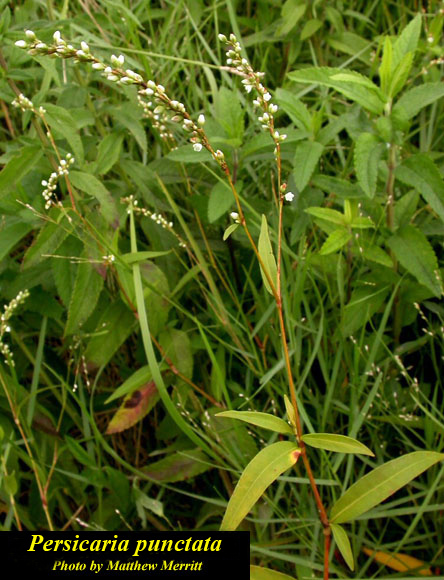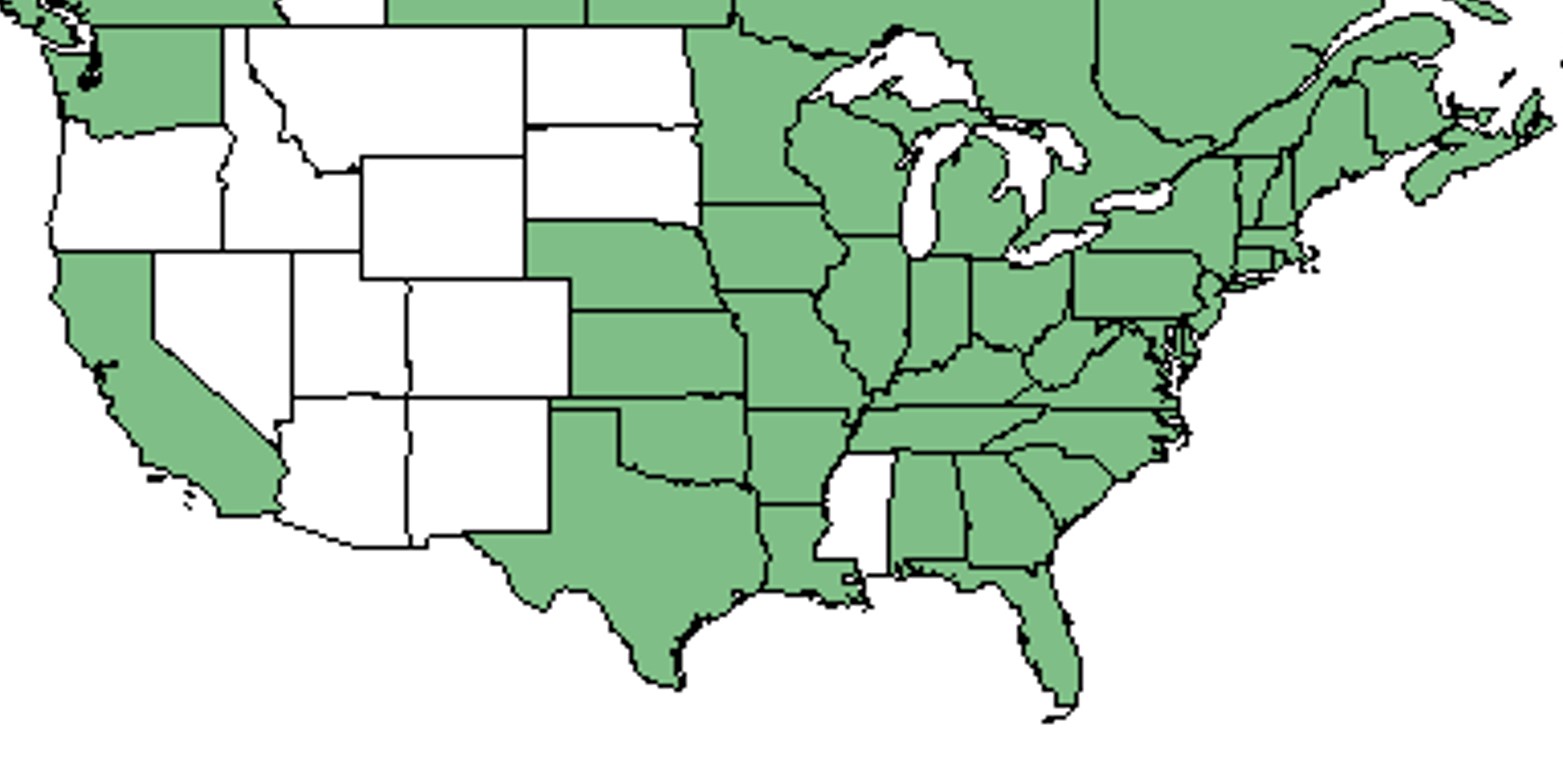Difference between revisions of "Persicaria punctata"
HaleighJoM (talk | contribs) (→Ecology) |
|||
| (20 intermediate revisions by 5 users not shown) | |||
| Line 3: | Line 3: | ||
{{taxobox | {{taxobox | ||
| name = Persicaria punctata | | name = Persicaria punctata | ||
| − | | image = | + | | image = Pers_punc.jpg |
| − | | image_caption = | + | | image_caption = Photo by Matthew Merritt, [http://www.florida.plantatlas.usf.edu/Default.aspx Atlas of Florida Vascular Plants] |
| regnum = Plantae | | regnum = Plantae | ||
| divisio = Tracheophyta- Vascular plants | | divisio = Tracheophyta- Vascular plants | ||
| Line 18: | Line 18: | ||
}} | }} | ||
| − | Common name: Dotted | + | Common name: Dotted smartweed<ref name="weakley">Weakley, A.S. 2015. Flora of the southern and mid-atlantic states. Working Draft of 21 May 2015. University of North Carolina at Chapel Hill, Chapel Hill, North Carolina.</ref> |
| + | |||
==Taxonomic notes== | ==Taxonomic notes== | ||
| − | + | Synonyms: ''Persicaria punctata'' (Elliott) Small var. ''punctata''; ''Polygonum punctatum'' Elliott; ''Polygonum punctatum'' Elliott var. ''punctatum''; ''Persicaria punctata'' (Elliott) Small var. ''leptostachya'' (Meisner) Small; ''Polygonum punctatum'' Elliott var. ''leptostachyum'' (Meisner) Small; ''Polygonum punctatum'' var. ''parvum'' Marie-Victorin & Rousseau; ''Polygonum punctatum'' Elliott var. ''confertiflorum'' (Meisner) Fassett.<ref name="weakley">Weakley, A.S. 2015. Flora of the southern and mid-atlantic states. Working Draft of 21 May 2015. University of North Carolina at Chapel Hill, Chapel Hill, North Carolina.</ref> | |
| − | The species name punctata is derived from Latin, meaning dotted. This refers to the dotted glands of the flowers<ref name="friends">[[http://www.friendsofthewildflowergarden.org/pages/plants/smartweed_dotted.html]]Plants of the Eloise Butler Wildflower Garden. Accessed: February 20, 2016</ref> | + | The species name "punctata" is derived from Latin, meaning dotted. This refers to the dotted glands of the flowers.<ref name="friends">[[http://www.friendsofthewildflowergarden.org/pages/plants/smartweed_dotted.html]]Plants of the Eloise Butler Wildflower Garden. Accessed: February 20, 2016</ref> |
| − | |||
| − | |||
==Description== | ==Description== | ||
<!-- Basic life history facts such as annual/perrenial, monoecious/dioecious, root morphology, seed type, etc. --> | <!-- Basic life history facts such as annual/perrenial, monoecious/dioecious, root morphology, seed type, etc. --> | ||
| − | A description of ''Persicaria punctata'' is provided in [http://efloras.org/florataxon.aspx?flora_id=1&taxon_id=242100107 The Flora of North America]. | + | A description of ''Persicaria punctata'' is provided in [http://efloras.org/florataxon.aspx?flora_id=1&taxon_id=242100107 The Flora of North America]. The Radford Flora describes it as an "annual or rhizomatous perennial with erect, terete, glabrous or short-strigose stems. Leaves are glabrous to short-strigose, 6-15 cm long, 1-3 cm wide, tapered to petioles 2-20 mm long; ocreae strigose, 1-2 cm long, cilia 1-8 mm long. Racemes straight or arching, densely to very loosely flowered. Calyx white or greenish, rarely tinged with red or pink, conspicuously glandular-punctate. Nutlets black, glossy, trigonous or biconvex, 2.5-3 mm long."<ref name="Radford et al 1964"/> |
| − | |||
| − | |||
| − | |||
| − | " | ||
==Distribution== | ==Distribution== | ||
| − | ''P. punctata'' is found throughout most of the United States, | + | ''P. punctata'' is found throughout most of the United States, ranging from Novia Scotia, Ontario, and British Columbia, south to Florida, Texas, and California, and even extending into the New World Tropics.<ref name="weakley">Weakley, A.S. 2015. Flora of the southern and mid-atlantic states. Working Draft of 21 May 2015. University of North Carolina at Chapel Hill, Chapel Hill, North Carolina.</ref> It is introduced instead of being native in Idaho, Montana, Colorado, Utah, Wyoming, and Hawaii.<ref name="uswildflowers">[[http://uswildflowers.com/detail.php?SName=Persicaria%20punctata]] Wildflowers of the United States. Accessed: February 20, 2016</ref> |
==Ecology== | ==Ecology== | ||
===Habitat=== <!--Natural communities, human disturbed habitats, topography, hydrology, soils, light, fire regime requirements for removal of competition, etc.--> | ===Habitat=== <!--Natural communities, human disturbed habitats, topography, hydrology, soils, light, fire regime requirements for removal of competition, etc.--> | ||
| − | ''P. punctata'' is found in wet areas such as floodplain forests, swamps, seeps, pond shores, and drainage ditches<ref name="illinois">[[http://www.illinoiswildflowers.info/wetland/plants/water_smartweed.htm]]Illinois Wildflowers. Accessed: February 20, 2016</ref> | + | ''P. punctata'' is found in wet areas such as floodplain forests, swamps, seeps, pond shores, and drainage ditches.<ref name="illinois">[[http://www.illinoiswildflowers.info/wetland/plants/water_smartweed.htm]]Illinois Wildflowers. Accessed: February 20, 2016</ref> In the Coastal Plain in Florida, ''P. punctata'' has been found in wet margins of wax myrtle thickets.<ref name="FSU Herbarium">Florida State University Robert K. Godfrey Herbarium database. URL: [http://herbarium.bio.fsu.edu http://herbarium.bio.fsu.edu]. Last accessed: November 2015. Collectors: Cecil R. Slaughter. States and Counties: Florida: St. Johns, Volusia. Compiled by Tall Timbers Research Station and Land Conservancy.</ref> It prefers full to partial sun in mucky soil rich in organic matter and will tolerate shallow standing water.<ref name="illinois"/> |
===Phenology=== <!--Timing off flowering, fruiting, seed dispersal, and environmental triggers. Cite PanFlora website if appropriate: http://www.gilnelson.com/PanFlora/ --> | ===Phenology=== <!--Timing off flowering, fruiting, seed dispersal, and environmental triggers. Cite PanFlora website if appropriate: http://www.gilnelson.com/PanFlora/ --> | ||
| − | + | This species flowers July through November<ref name="weakley">Weakley, A.S. 2015. Flora of the southern and mid-atlantic states. Working Draft of 21 May 2015. University of North Carolina at Chapel Hill, Chapel Hill, North Carolina.</ref> | |
===Seed dispersal=== | ===Seed dispersal=== | ||
| − | The seeds are not adapted for dispersal other than floating in water, however, it is postulated to be transported by mud on the feet of water birds<ref name="cabi"/>. | + | The seeds are not adapted for dispersal other than floating in water, however, it is postulated to be transported by mud on the feet of water birds.<ref name="cabi"/> |
| + | <!--===Seed bank and germination===--> | ||
| + | <!--===Fire ecology===--> <!--Fire tolerance, fire dependence, adaptive fire responses--> | ||
| + | <!--===Pollination===--> | ||
| + | ===Herbivory and toxicology=== <!--Common herbivores, granivory, insect hosting, poisonous chemicals, allelopathy, etc--> | ||
| + | ''Persicaria punctata'' has been observed to host plant bugs from the Miridae family such as ''Lygus lineolaris''.<ref>Discoverlife.org [https://www.discoverlife.org/20/q?search=Bidens+albaDiscoverlife.org|Discoverlife.org]</ref> The seeds are eaten by ducks and various songbirds.<ref name="illinois"/> | ||
| + | <!--===Diseases and parasites===--> | ||
| − | == | + | ==Conservation, cultivation, and restoration== |
| − | |||
| − | == | ||
| − | |||
| − | |||
| − | == | + | ==Cultural use== |
| − | + | Historically, the Chippewa used the leaves and flowers to treat stomach pain, and the Houma used roots to treat joint pain.<ref name="gobotany">[[https://gobotany.newenglandwild.org/species/persicaria/punctata/]]Go Botany. Accessed: February 20, 2016</ref> | |
| − | |||
| − | Historically, the Chippewa used the leaves and flowers to treat stomach pain, and the Houma used roots to treat joint pain<ref name="gobotany">[[https://gobotany.newenglandwild.org/species/persicaria/punctata/]]Go Botany. Accessed: February 20, 2016</ref> | ||
==Photo Gallery== | ==Photo Gallery== | ||
<gallery widths=180px> | <gallery widths=180px> | ||
| − | </gallery> | + | File: Pers_punc4_MattMerrit_ISB-AtlasofFLPlants.jpg | <center> ''Persicaria punctata'' flowers <p> Photo by Matthew Merritt, [http://www.florida.plantatlas.usf.edu/Default.aspx Atlas of Florida Vascular Plants] </gallery> |
==References and notes== | ==References and notes== | ||
| − | |||
| − | |||
| − | |||
Latest revision as of 12:28, 15 July 2022
| Persicaria punctata | |
|---|---|

| |
| Photo by Matthew Merritt, Atlas of Florida Vascular Plants | |
| Scientific classification | |
| Kingdom: | Plantae |
| Division: | Tracheophyta- Vascular plants |
| Class: | Magnoliopsida – Dicotyledons |
| Order: | Caryophyllanae |
| Family: | Polygonaceae |
| Genus: | Persicaria |
| Species: | P. punctata |
| Binomial name | |
| Persicaria punctata (Elliott) Small | |

| |
| Natural range of Persicaria punctata from USDA NRCS Plants Database. | |
Common name: Dotted smartweed[1]
Contents
Taxonomic notes
Synonyms: Persicaria punctata (Elliott) Small var. punctata; Polygonum punctatum Elliott; Polygonum punctatum Elliott var. punctatum; Persicaria punctata (Elliott) Small var. leptostachya (Meisner) Small; Polygonum punctatum Elliott var. leptostachyum (Meisner) Small; Polygonum punctatum var. parvum Marie-Victorin & Rousseau; Polygonum punctatum Elliott var. confertiflorum (Meisner) Fassett.[1]
The species name "punctata" is derived from Latin, meaning dotted. This refers to the dotted glands of the flowers.[2]
Description
A description of Persicaria punctata is provided in The Flora of North America. The Radford Flora describes it as an "annual or rhizomatous perennial with erect, terete, glabrous or short-strigose stems. Leaves are glabrous to short-strigose, 6-15 cm long, 1-3 cm wide, tapered to petioles 2-20 mm long; ocreae strigose, 1-2 cm long, cilia 1-8 mm long. Racemes straight or arching, densely to very loosely flowered. Calyx white or greenish, rarely tinged with red or pink, conspicuously glandular-punctate. Nutlets black, glossy, trigonous or biconvex, 2.5-3 mm long."[3]
Distribution
P. punctata is found throughout most of the United States, ranging from Novia Scotia, Ontario, and British Columbia, south to Florida, Texas, and California, and even extending into the New World Tropics.[1] It is introduced instead of being native in Idaho, Montana, Colorado, Utah, Wyoming, and Hawaii.[4]
Ecology
Habitat
P. punctata is found in wet areas such as floodplain forests, swamps, seeps, pond shores, and drainage ditches.[5] In the Coastal Plain in Florida, P. punctata has been found in wet margins of wax myrtle thickets.[6] It prefers full to partial sun in mucky soil rich in organic matter and will tolerate shallow standing water.[5]
Phenology
This species flowers July through November[1]
Seed dispersal
The seeds are not adapted for dispersal other than floating in water, however, it is postulated to be transported by mud on the feet of water birds.[7]
Herbivory and toxicology
Persicaria punctata has been observed to host plant bugs from the Miridae family such as Lygus lineolaris.[8] The seeds are eaten by ducks and various songbirds.[5]
Conservation, cultivation, and restoration
Cultural use
Historically, the Chippewa used the leaves and flowers to treat stomach pain, and the Houma used roots to treat joint pain.[9]
Photo Gallery
Persicaria punctata flowers Photo by Matthew Merritt, Atlas of Florida Vascular Plants
References and notes
- ↑ 1.0 1.1 1.2 1.3 Weakley, A.S. 2015. Flora of the southern and mid-atlantic states. Working Draft of 21 May 2015. University of North Carolina at Chapel Hill, Chapel Hill, North Carolina.
- ↑ [[1]]Plants of the Eloise Butler Wildflower Garden. Accessed: February 20, 2016
- ↑ Cite error: Invalid
<ref>tag; no text was provided for refs namedRadford et al 1964 - ↑ [[2]] Wildflowers of the United States. Accessed: February 20, 2016
- ↑ 5.0 5.1 5.2 [[3]]Illinois Wildflowers. Accessed: February 20, 2016
- ↑ Florida State University Robert K. Godfrey Herbarium database. URL: http://herbarium.bio.fsu.edu. Last accessed: November 2015. Collectors: Cecil R. Slaughter. States and Counties: Florida: St. Johns, Volusia. Compiled by Tall Timbers Research Station and Land Conservancy.
- ↑ Cite error: Invalid
<ref>tag; no text was provided for refs namedcabi - ↑ Discoverlife.org [4]
- ↑ [[5]]Go Botany. Accessed: February 20, 2016
